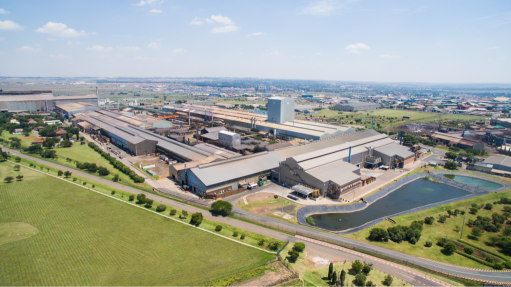
MPUMALANGA FACILITY The integrated facility has been instrumental in advancing stainless steel production and application
Using stainless steel in the sugar industry, where processing conditions can be particularly corrosive, has proven to be an effective solution in mitigating wear-related challenges, says South African stainless steel mill Columbus Stainless market development manager Lerato Mashigo.
Stainless steel’s superior corrosion resistance, coupled with economic benefits identified through life- cycle costing, validates the material’s selection, she says.
Life-cycle costing is a financial analysis tool that evaluates the total cost of ownership over an asset’s lifespan. It considers initial acquisition, operation, maintenance and disposal costs.
When applied to materials selection, it reveals that stainless steel, despite its higher initial cost, often results in lower overall expenses, owing to its durability and minimal maintenance requirements, highlighting its cost efficiency over time, which can be obscured by the initial cost barrier, Mashigo states.
During sugar production, uncleaned sugar cane adds sand and stone to the process, exacerbating wet abrasion and corrosion challenges. Traditional mild steel equipment, vulnerable to abrasion, frequently requires replacement and repair, driving up maintenance costs.
Conversely, 3CR12 stainless steel’s superior wet sliding and corrosion resistance significantly extends equipment life and improves material flow, offering cost-effective performance, compared with other grades.
Using the 3CR12 grade in cane handling, bagasse processing and various storage applications delivers notable benefits. These include lower initial installation costs owing to lower wall-thickness requirements, a fivefold to tenfold increase in equipment longevity, and decreased maintenance and downtime, affirming its value in the sugar industry since the 1980s, Mashigo explains.
She says the development of utility ferritic grade 3CR12 stainless steel by Columbus Stainless in the 1970s has since achieved global success in the industry.
“Designed to offer an economical alternative for structural applications, bridging the gap between carbon steels and higher-end stainless steels, 3CR12 boasts durability, versatility and the core advantages of stainless steels such as comparable strength to mild steels and reliable welding capabilities for thick sections up to 30 mm.”
She adds that, as the industry continues to confront corrosion challenges, stainless steel remains a key component in achieving operational efficiency and sustainability.
In contrast to carbon steels, which are prone to rust when unprotected, stainless steel incorporates chromium, which reacts with oxygen to form a protective chromium oxide layer.
This layer shields the underlying metal from further corrosion, making stainless steel an optimal choice for applications requiring durability in corrosive environments. The chromium content must be at least 10.5% to effectively prevent corrosion, Mashigo says.
Stainless steel also contributes to environmental sustainability, as it is 100% recyclable, with a substantial portion of new stainless steel being manufactured from recycled material.
This characteristic reduces the need for raw material extraction, lowers energy consumption, and diminishes the environmental impact associated with the production of new steel, Mashigo explains, adding that, in the sugar industry, the extended service life of stainless steel components lessens the environmental footprint by reducing waste.
Columbus Stainless, which operates an integrated facility, has been instrumental in advancing stainless steel production and application, she tells Engineering News.
“Our focus on innovation, coupled with a commitment to customer support, has facilitated the development of stainless steel grades tailored to industry needs,” Mashigo concludes.